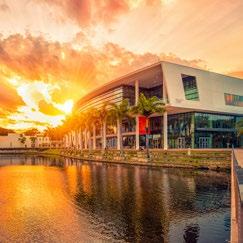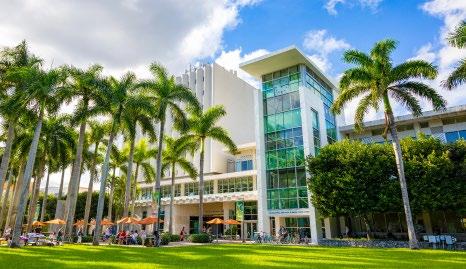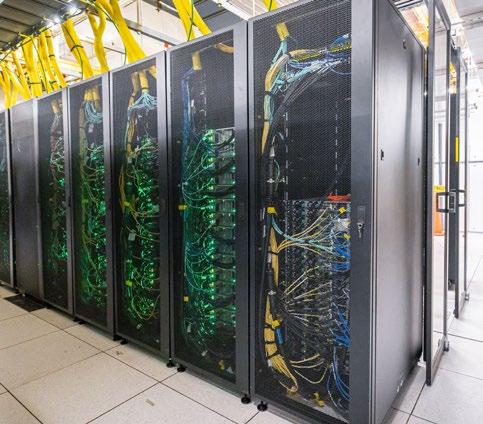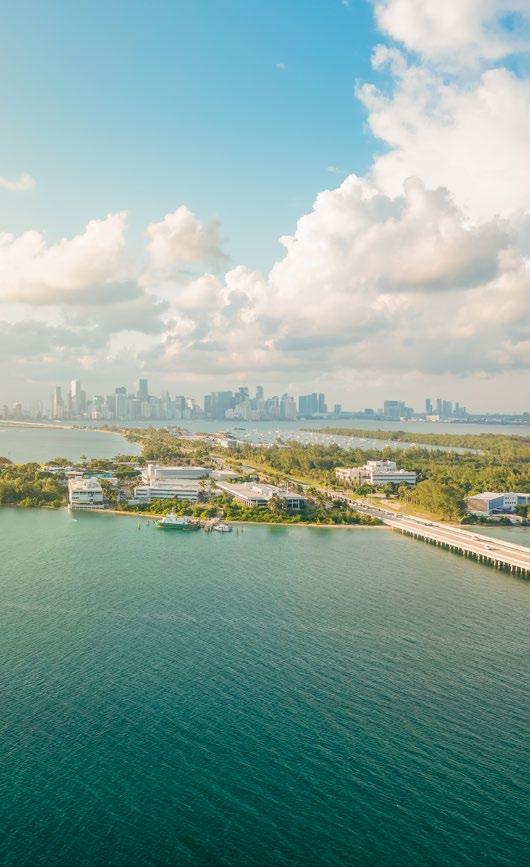individualswithpart-time employeeswhoteachpart-time. allgraduatestudentsandfacultyin inthecalculation.

due to rounding. 1Includes M.D., J.D., and other graduate students.
2Part-timefacultyismeasuredbythenumberofindividualswithpart-time instructionalactivities,including57non-facultyemployeeswhoteachpart-time. 3FollowingCDSinstructions.AsofFall2024,allgraduatestudentsandfacultyin stand-alonegraduateprogramsareexcludedinthecalculation.

HISTORY
Founded 1925; classes began October 1926
OFFICERS
Joseph “Joe” Echevarria, president and chief executive officer; Joel Samuels, executive vice president for academic affairs and provost; Rudy Fernandez, executive vice president for university operations and external affairs and chief of staff to the president.
CAMPUSES AND FACILITIES
Coral Gables Campus: The Coral Gables Campus, with its two colleges and eight schools, is located on a 240-acre tract in the City of Coral Gables.
Medical Campus: UHealth – University of Miami Health System, powered by the Leonard M. Miller School of Medicine, is dedicated to revolutionary research, education and compassionate care. Its 70-acre medical campus, located within the Miami Health District, is home to nationally ranked programs*, including Bascom Palmer Eye Institute (No. 1), neurology/neurosurgery (No. 23), and Sylvester Comprehensive Cancer Center (No. 45)—the only NCI-designated cancer center in South Florida. Most recently UHealth received further accolades, becoming the first and only health system in Florida to achieve Nurse Magnet with Distinction®, placing it in the top 1% of U.S. hospitals in the nation holding this honor. UHealth is affiliated with Jackson Memorial Hospital and the Bruce W. Carter Department of Veterans Affairs Medical Center. UHealth has 40 outpatient clinics across Miami-Dade, Broward, Palm Beach, and Collier counties. Recent expansions include UHealth Doral Medical Center, a six-story multispecialty facility in Downtown Doral, and UHealth SoLé Mia in North Miami, the health system’s largest multispecialty ambulatory care clinic, standing at seven stories and 370,000 square feet. With more than 2,700 providers across 100+ specialties and
*U.S. News & World Report, Best Hospitals, 2025–2026
subspecialties, UHealth delivers outcomes that rank among the best in the nation. Research is a driving force on the medical campus, highlighted by the Kenneth C. Griffin Cancer Research Building. Faculty at the Miller School lead more than 1,700 research projects and secured $165 million in NIH funding in FY 2024.
Marine Campus: The Rosenstiel School of Marine, Atmospheric, and Earth Science is located on an 18-acre waterfront campus on Virginia Key in Miami-Dade County, on Biscayne Bay. It is the only subtropical research institute of its kind in the continental United States. Founded in 1943, the Rosenstiel School has grown into one of the world’s premier earth science research institutions.
Richmond Facility: The Richmond Facility, established in 2001, is a 76-acre site that houses research facilities for the Rosenstiel School’s Center for Southeastern Tropical Advanced Remote Sensing (CSTARS) and the Richmond Satellite Operations Center.
ACCREDITATION
The University is accredited by the Southern Association of Colleges and Schools Commission on Colleges (SACSCOC) and 27 other professional agencies.
PROGRAMS
The University offers 154 bachelor’s, 150 master’s, and 70 doctoral (65 research/scholarship and five professional practice) programs.
DEGREES AWARDED
In 2024-25, the University awarded 3,005 bachelor’s, 1,799 master’s, 199 Ph.D., 115 other doctoral, 409 J.D., 200 M.D., and 102 other professional practice degrees, as well as 13 undergraduate and 161 graduate certificates.
CLASS SIZE
Fifty percent of classes for undergraduates have 18 or fewer students; 75% have 30 or fewer students.
30 or fewer students
HONORS PROGRAM/HONOR SOCIETIES
More than 1,100 undergraduates participate in the Foote Fellows Honors Program. The University has more than 40 academic honor societies, including Phi Beta Kappa.
DUAL-DEGREE PROGRAMS
The University of Miami offers 119 dual degree programs in which students can pursue multiple degrees concurrently. These include one dual bachelor’s degree program, 56 dual bachelor’s-graduate degree programs; and 62 dual graduate programs.
NEW FIRST-YEAR STUDENT STANDINGS
Out of those reporting a high school rank, 41% graduated in top 5% and 59% graduated in top 10%. Mean ACT composite was 31, and mean SAT combined was 14001 50% 18 or fewer students
STUDY ABROAD
Students can apply their financial aid and scholarship to semester programs, including University of Miami on-location programs in San Jose, Costa Rica; Prague, Czech Republic; the Galapagos Islands, Ecuador; Paris, France; Rome, Italy; Kyoto and Tokyo, Japan; Cape Town, South Africa; Barcelona, Madrid, and Seville, Spain; London, United Kingdom; and a multilocation program in Latin America. Scholarship funding also applies to semester exchange-partner programs in more than 40 countries. While funding is limited, faculty-led study abroad programs are offered during intersession, spring break, and summer.
SPORTS
The University has competed in intercollegiate athletics since 1926 and is now a member of the Atlantic Coast Conference. The Hurricanes field 18 teams across men’s and women’s athletics and have won 21 team national championships and 87 individual national titles over their illustrious history. University of Miami student-athletes posted a graduation success rate of 93% in NCAA latest report, compared with the national average of 90%.
Men: Baseball (1982, 1985, 1999, 2001 national champions); Basketball; Cross Country; Football (1983, 1987, 1989, 1991, 2001 national champions); Diving; Tennis; Indoor Track and Field; Outdoor Track and Field.
Women: Basketball; Cross Country; Golf (1970, 1972, 1977, 1978, 1984 national champions); Rowing; Soccer; Swimming and Diving (1975, 1976 national champions); Tennis; Indoor Track and Field; Outdoor Track and Field; Volleyball.
RESIDENT STUDENTS
There are 4,658 students who live on campus, including 88% of first-time degree-seeking students (those who have no prior college experience) and 36% of all degree-seeking undergraduates. Housing facilities include five residential colleges, Lakeside Village, and University Village apartments.
INDIVIDUAL NATIONAL TITLES TEAM NATIONAL TITLES ATHLETICS GRADUATION SUCCESS RATE
93%
4,658
ALUMNI
Alumni live in all 50 states and 174 countries. There are 109,981 alumni residing in Florida, including more than 56,800 in MiamiDade County. There are more than 240,769 alumni in the University’s history.
All 50 states
109,981
174 countries
LIBRARIES
The University of Miami Libraries include the Otto G. Richter Library and libraries in the architecture, business, law, medical, music, and marine schools, providing access to more than 4 million volumes; 170,579 current serials titles; 169,928 electronic journals; 1,710,981 electronic books; over 4 million microforms; and 244,773 audio, film, video, and cartographic materials. The libraries’ digital collections feature 1,577,962 images and document pages. The University’s research repository, “Scholarship@Miami,” managed by the libraries, hosts 181,073 theses, dissertations, research publications, creative works, and datasets.


COMPUTING CENTER
The University of Miami maintains data centers in several locations and has adopted a hybrid strategy that offers both cloud options and dedicated supercomputers. The Frost Institute for Data Science and Computing has two supercomputers, including Triton, one of the top academic supercomputers in the U.S. Triton represents a quantum leap in the University’s computing infrastructure and is designed to address the everexpanding needs of data-driven research.
The institute supports hardware infrastructure and design/ implementation solutions. The University is an equity member of Florida LambdaRail, providing 100Gbps connectivity throughout the state and to Internet2. Secured and guest wireless networks on all campuses complement the extensive wired network.
There are over 60 computer labs located in residential colleges, libraries, schools, and colleges, and over 900 computers available
for student use. In addition, a virtual computer lab system provides students with access to key software from any location. Commonly used productivity software—including Microsoft Office, Adobe Creative Cloud, statistical packages, and research software—are licensed for use on students’ personal devices. This includes Copilot, Gemini, Adobe Firefly, and more— which students can use to create content and images using a generative artificial intelligence (AI) system. Students can also access Google Drive, OneDrive, and Box for cloud storage and online collaboration. Blackboard Ultra is the course management system used by faculty, staff, teaching assistants, and students. The Student Technology Help Desk provides students with walkin service software installation, account and printing support, virus removal, operating system installation, and repairs.
RESEARCH
Within research and sponsored programs, the University had 2,619 active awards, expenditures totaled $520 million, and total awards were $526 million last year (FY25). The University of Miami is an R1 institution, recognized for its high level of research activity under the Carnegie Classification of Institutions of Higher Education.
BUDGET
The FY 2026 Budget is $6.6 billion, with $5.4 billion projected for the Medical Campus. At the end of FY 2025, the endowment for the University was $1.71 billion.
$6.6b BUDGET $1.71b ENDOWMENT
DEVELOPMENT
In FY 2025, contributions reached $247.4 million total private cash, gifts, and grants.

Faculty and Employees | Fall 20251
Faculty Characteristics | Fall
1As
Enrollment by School | Fall 2025
Full-Time Equivalent | Fall 2025
1Includes M.D., J.D., and other graduate students.
2Excludes IEP and auditing students.
New Student Enrollment | Fall 2025
Enrollment by Race/Ethnicity | Fall
Enrollment by Geographic Origin |
by Gender | Fall
Tables above include full- and part-time students. Percentages may not total 100 due to rounding.
1Includes M.D., J.D., and other graduate students.
2Students come from 50 states, 2 territories, and 134 other countries.
Credit Hours Taught | Fall 2025
1Total credit hours by teaching school. Research courses taken for zero credit hours increased to one credit hour.
1Values shown are based on assumed traditional, full-time enrollment. Amounts may be prorated based on a student’s actual enrollment after add/drop.
2Based on the weighted average housing charges for on campus residence and 21 meals a week through the campus dining plan. Actual housing and food costs may vary based on housing and meal plan choices.
3For domestic students living in the 48 contiguous states. For those from Alaska or Hawaii, or for international students, the estimated transportation allowance is $4,080.
4In millions; revised awards may change some amounts slightly; includes summer awards; total may differ due to rounding. Aid amounts are calculated using the complete student population across all levels (Undergraduate, Graduate, Law, and Medical School) as of the Fall 2025 benchmark snapshot.
Financial Highlights | 2024-251
1For the fiscal year ending May 31, 2025, in millions.
2Includes the effect of accumulated depreciation and amortization of $2,889.2 million.

